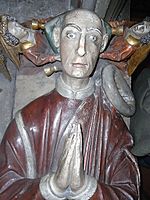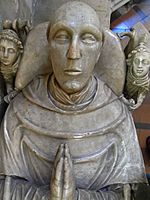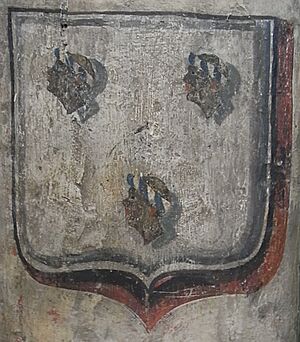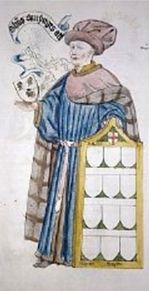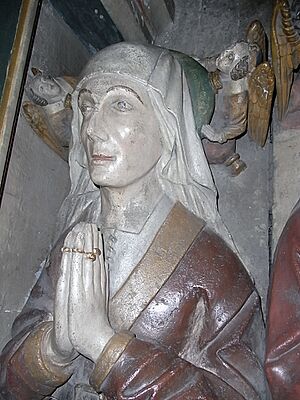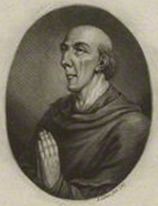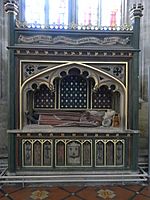William II Canynges facts for kids
William II Canynges (born around 1399, died 1474) was a very rich English merchant and ship owner from Bristol. He was one of the wealthiest people in his time and sometimes helped the King with money. He served as the Mayor of Bristol five times and was elected as a Member of Parliament (MP) for Bristol three times.
Canynges was also a generous supporter of art and building projects in Bristol, especially for St Mary Redcliffe Church. This church is often called "The crown of Bristol architecture." After his wife Joan died in 1467, he decided to leave his business and political life. He became a priest in 1468 and served in the church until he died six years later. His tomb in St Mary's Church later inspired the young poet Thomas Chatterton to write a poem about him.
Contents
Early Life and Family
William Canynges was born in Bristol around 1399 or 1400. He came from a rich family of merchants and cloth makers in the city. His father, John Canynges, died young in 1405. William was one of seven children.
His older brother, Thomas Canynges, became the Lord Mayor of London in 1456–7. He was also an Alderman (a senior member of the city council) and a Grocer (a merchant dealing in spices and other goods).
William's grandfather, William I Canynges (died 1396), was also a very important Bristol merchant. He was Mayor of Bristol five times and an MP for Bristol three times. William II's father, John Canynges, was also Mayor of Bristol twice and an MP once.
William's mother, Joan Wotton, later married Thomas Young. They had two successful sons: John Young, who became Lord Mayor of London in 1466, and Thomas Young, a lawyer and MP for Bristol. Thomas Young served as an MP alongside his half-brother William II Canynges.
Marriage and Family Life
Before 1429, William married Joan Burton, who also came from an important Bristol family. Joan's sister Isabel married William's half-brother, Thomas Young.
William and Joan had two sons. Their father wanted them to become part of the gentry (a class of wealthy landowners). However, both sons died before William did. This meant the Canynges family line in Bristol came to an end. Joan died in September 1467. After this sad event, William decided to change his life and become a priest.
Business Career
William Canynges inherited a lot of money and had good connections from his family's trade. However, he didn't focus on making cloth like his ancestors. Instead, he specialized in shipping cloth to southern Europe.
In 1436, he became the Constable of the Merchants of the Staple. This was an important role in the wool export business. In 1441, he became a Grocer, like his half-brother John Young.
Investing in Sea Voyages
Canynges invested in a risky sea trip in 1457 led by Robert Sturmey, another Bristol merchant and mayor. This trip aimed to sail to the Aegean Sea to break the Italian monopoly (when one group controls all of something) on trade with the East. They wanted to set up an English trading post in the Middle East.
Canynges and other investors paid for three ships filled with cloth, tin, and lead. The ships traded well, but Genoese pirates attacked them near Malta. Two ships were lost, and Sturmey himself died. The King later fined the Genoese traders in England £6,000 for the damage. This event stopped English trips to the Mediterranean for many years. However, it also made England look west, which later led to John Cabot's famous voyage in 1497.
Owning a Large Fleet
William Canynges became known for shipping other people's goods rather than just trading his own. He owned at least ten ships, which was one of the largest fleets in England at the time. It's said he employed 800 sailors.
Three of his ships were very large for that era, weighing over 200 tons. The Mary Canynges was 400 tons, the Mary Redcliffe was 500 tons, and the Mary and John was a huge 900 tons. This last ship was called "a monster" and cost a lot of money to build. His total ship weight was almost 3,000 tons.
Trade with Northern Europe
Canynges also traded with countries in Scandinavia. He exported cloth and brought back fish. He even had a special permission from the King of Denmark that gave him a monopoly on the fish trade between Iceland, Finland, and England for a while. He also successfully competed with merchants from Flanders in the Baltic Sea, gaining a large share of their business.
Political Life
Canynges started his public career in 1432 as a bailiff (a local official) in Bristol. In 1438, he became the Sheriff. He was elected mayor of Bristol five times, first in September 1441 when he was still under 40. He also served as Mayor in 1449, 1456, 1461, and 1466. He was elected as an MP for Bristol three times: in 1439, 1450–1, and 1455.
Connections with Royalty
In 1456, Canynges hosted Queen Margaret of Anjou, the wife of the Lancastrian King Henry VI, in Bristol.
William's half-brother, Thomas Young, was imprisoned in 1450 for suggesting in Parliament that Richard, Duke of York should be the heir to the throne instead of King Henry VI. Canynges seemed to support the Yorkist side too. In 1450, during his third term as mayor, he stopped gunpowder meant for use against the Duke of York from being sold in Bristol. He also took control of Bristol Castle for the Duke, holding it against the Duke's rival.
In September 1461, after King Henry VI was removed from power, Canynges welcomed the Duke of York's son, the new Yorkist King Edward IV, to Bristol. Canynges even loaned the new King 500 marks (a type of money).
Supporter of the Arts
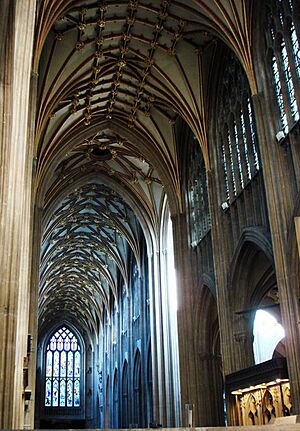
William Canynges paid for a lot of the rebuilding work on the great St Mary Redcliffe Church in Bristol. For a long time, he had a hundred workers regularly employed for this project. He also added valuable items and equipment to the church.
In 1466 and 1467, he set up two chantries (places where priests would pray for the souls of the dead). He provided £340 to support two "St Mary priests" and three other church officials. His house in Bristol, which had a beautiful Gothic oak roof, was still standing in 1884.
Other Bristol merchants, like John Shipward (died 1473), also generously supported the arts. Shipward paid for the building of the tower of St Stephen's Church. They both followed the example of Walter Frampton (died 1357), who was Mayor of Bristol three times and funded the building of the Church of St John the Baptist.
Becoming a Priest
The death of his wife Joan in September 1467 was a major turning point for Canynges. He decided to give up his business and political life to join the church.
Bristol was part of the Diocese of Worcester at that time. Bishop John Carpenter of Worcester helped him become a priest. Canynges first became the rector of St Alban's, Worcester. On September 19, 1467, he was admitted to the order of acolyte (a church assistant). He was then ordained as a priest on April 16, 1468.
He was appointed a canon of the Collegiate Church of Westbury-on-Trym and a prebendary (a type of church official). He held his first mass in St Mary Redcliffe, the church he had so generously supported, during the following Whitsuntide (a Christian festival). He moved from Redcliffe to Westbury, where he became the dean (a senior church leader) in June 1469. He stayed there until he died five years later in 1474.
Death and Burial
William Canynges died on November 17 or 19, 1474. He was buried in St Mary Redcliffe Church in Bristol. A stone tomb with a canopy was built in his memory in the south aisle of the church. It holds a statue of him in his red mayoral robes, next to a statue of his wife Joan.
A funeral service was also held at Westbury-on-Trym. A very well-made statue of him, dressed in his priest's clothes, was placed there. After the Dissolution (when monasteries were closed down), this statue was moved to St Mary Redcliffe Church. It is now next to his original tomb. The tombstone of Canynges's cook is nearby, decorated with carvings of cooking tools.
Family Descendants
The famous statesman George Canning and Stratford Canning, 1st Viscount Stratford de Redcliffe were later descendants of William Canynges's family.


